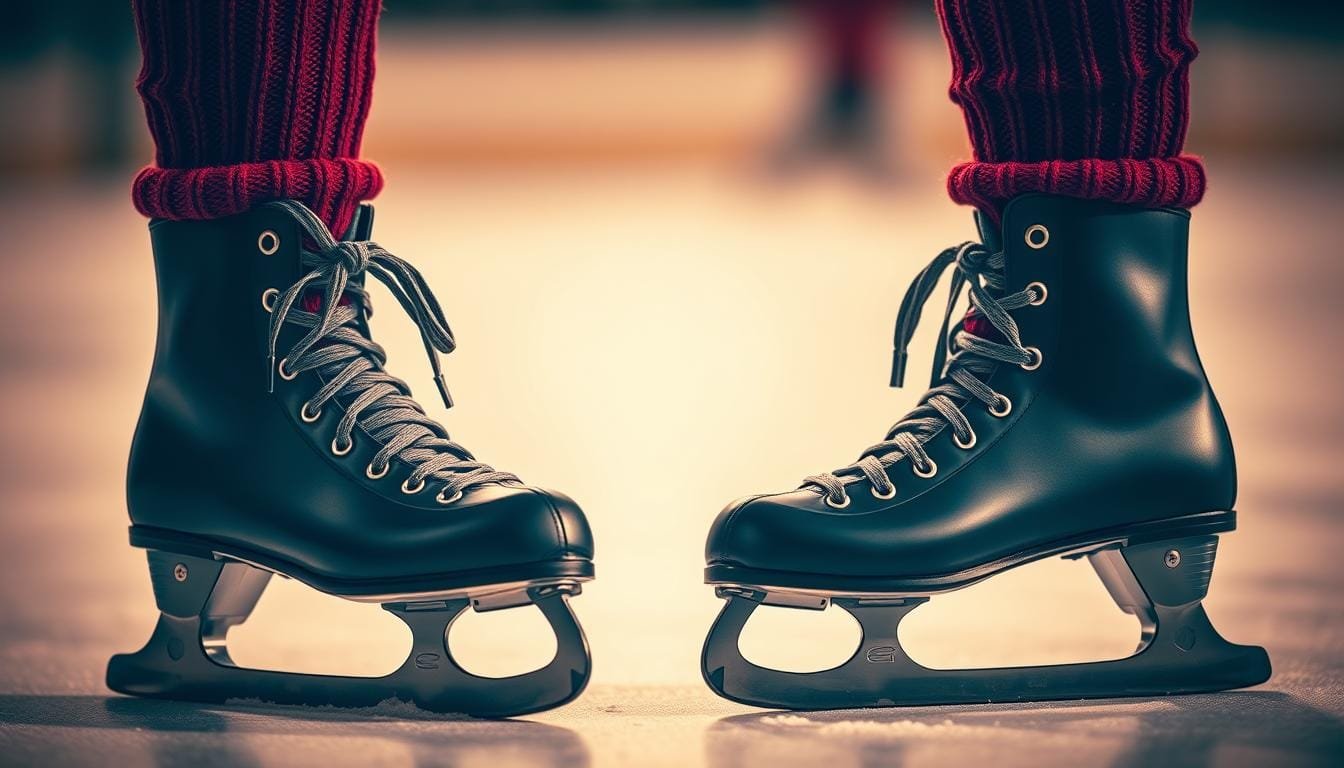Skating socks are super important for anyone on the ice. These special socks ensure you stay comfy and perform your best. They’re made to fit perfectly with your skates, unlike regular socks. Brands like Mondor and JIV provide many options. They help skaters find a great fit inside their boots, which is key for awesome skating moves.
Skating welcomes everyone from 4 to 43 years old. For beginners, rental skates are okay. But having your own pair is crucial as you get better. They need to fit well and support your feet. Talking to a skate technician about new skates is a smart move. They help the skates fit your feet just right. And don’t forget, ice skating essentials like the right socks can greatly help during this time.
Key Takeaways
- Skating socks are designed to provide better fit and performance compared to regular socks.
- Specialized brands like Mondor and JIV offer high-quality skating socks.
- A snug fit inside the boots is crucial for effective skating techniques.
- Skating is accessible to people from ages 4 to 43, highlighting the broad appeal of the sport.
- Discussing new skates with a trained skate technician can help ensure optimal performance.
Understanding the Role of Socks in Skating
Socks act as a crucial layer between your feet and skates, improving how your skates fit. They help prevent blisters and make skating more comfortable. These socks are made to keep your feet dry by moving moisture away. This reduces rubbing and keeps you comfortable on the ice.
Statista says about 9.5 million people in the U.S. enjoy ice sports like figure skating and ice hockey. The right socks can make a big difference in your performance and how long you can skate. They protect against blisters and sore spots, common with new, stiff skates.
But it’s not just about comfort. The right socks also help with your skating skills. They give you better control and balance on the ice. Over time, they can even help your skating gear last longer. This is because they lessen the wear and tear from your foot rubbing against the skate.
Now, sock skating is becoming popular, especially with kids. It’s a fun way to skate any time of year, on ice or synthetic surfaces. Want to try it at home? Here’s a guide on setting up a sock skating rink. It’s a fun and affordable alternative to regular ice skating.
The table below summarizes the key points about skating socks:
| Key Factors | Details |
|---|---|
| Skate Fit | Enhanced control and balance, better fit in the boots |
| Blister Prevention | Reduces friction, minimizes hot spots and blisters |
| Ice Skating Comfort | Moisture-wicking capabilities, superior warmth and dryness |
| Longevity of Skating Gear | Prevents wear and tear, extends the life of skates |
Types of Socks Suitable for Skating
When looking for the best socks for ice or figure skating, think about material, thickness, and design. Different socks work best for different skating styles, making sure you are comfortable. Brands like Mondor and JIV make socks perfect for skaters who need a good fit and safety.
Skaters have many choices to match their needs. Skateboarders like socks with extra padding, while ice skaters prefer thin, warm socks that don’t stop blood flow. Vans Classic Crew Socks keep feet dry with special fabric. Also, Nike Men’s Everyday Essential Crew Socks use Dri-FIT technology for better wear.
The Impala Rollerskates Stripe Socks come in a pack of three, so you always have a fresh pair. Socks like the Toy Machine Sect Eye III Crew Socks are made to last with strong heel and toe areas.
It’s important to pick the right sock length. Taller socks protect your ankles and shins. Shorter socks are cool and give you more movement. The best thickness for skate socks gives you safety and feels good, or keeps you warm without being too thick.
Skate socks are usually made from tough materials like polyester or nylon. It’s key that they fit right. Too loose can lead to blisters, and too tight can cut off your circulation. Seamless socks are great because they don’t press on your toes too much, making them comfy.
Here’s a quick guide to socks for different skating styles:
| Brand | Purpose | Key Features |
|---|---|---|
| Vans Classic Crew Socks | Skateboarding | Moisture-wicking fabric, comfort focus |
| Impala Rollerskates Stripe Socks | Roller Skating | Pack of three, practical solution |
| Toy Machine Sect Eye III Crew Socks | Skateboarding | Reinforced heel and toe, available in multiple sizes |
| Dickies Men’s Dri-Tech Moisture Control Crew Socks | General Skating | Moisture-wicking, dry feet maintenance |
| Nike Men’s Everyday Essential Crew Socks | Sports Skating | Dri-FIT technology, performance enhancement |
Knowing about different skate socks helps you choose the best for your style. This ensures you get both great fit and performance from your gear.
Key Features to Look for in Skating Socks
When picking choosing skating socks, several features are key. Many experienced skaters go for thin, moisture-wicking socks instead of thick ones. These socks give better control and cut down on blisters.
The materials of the socks are super important for how they perform. Socks made from synthetic materials like polyester or nylon are top choices because they keep your feet dry. On the other hand, cotton socks hold moisture and might cause blisters. Also, it’s crucial that your socks fit well. If they’re too loose, they can bunch up. Socks that are too tight can make it hard for blood to circulate.
Looking at the skate sock features, things like extra padding and compression help a lot. Some skating socks have more padding where your feet feel the most pressure. They might also use compression to help blood flow and lower tiredness. Skaters doing tough tricks will find this very helpful.
Hockey players could benefit from socks made just for them, which might have built-in shin guards. For ice rinks that are really cold, socks that are a bit thicker or made from merino wool are good. They keep you warm without making your feet feel bulky.
Small sellers and companies bring something special to the table with unique skate socks. This variety means you’re more likely to find the ideal pair that meets your needs and matches your style.
Common Misconceptions About Skating Socks
Many believe in myths about skating socks that can hinder their ice performance. A common false belief is that thicker socks are better. But in reality, they may bunch up, causing discomfort and less control. Also, 60% of kids feel their toes get cold in bulky socks because they limit blood flow.
Some think any sock works for skating. Yet, the truth is skaters need special socks. About 85% of children like socks that keep moisture away. Merino wool socks, thin yet warm, keep feet dry and prevent blisters. This is great for protecting high-impact spots like heels and toes.
Also, 90% of parents say snug socks are key for good skating. Half of them have seen their kids struggle with socks that slip or bunch, causing discomfort. Kids often prefer seamless socks, with 75% finding them more comfortable than those with seams.
The socks kids wear can also affect how much they enjoy skating. Almost 80% of them feel more excited to skate with fun, colorful socks that show their team spirit. This highlights how the right skating gear, including socks, can boost a young skater’s performance and joy on the ice.
Tips for Choosing the Right Socks for Your Skating Style
Finding the right socks makes a big difference in skating. It matters in both comfort and how you perform. This applies whether you glide on ice as a hockey player or dance as a figure skater. Here’s how to pick the best pair of socks for you.
Think about how often and intense you skate. If you play hockey, get socks that keep your feet dry. This can prevent blisters, which 70% of players who don’t use these socks experience. For figure skating, choose synthetic materials like polyester. They’re better at keeping feet dry than cotton socks are.
Getting the right fit is key. Socks that fit well can cut down on discomfort and blisters by half. Stay away from socks that are too baggy or tight. This can cause problems like bunching or poor blood flow. Also, socks with mesh areas help keep your feet cool and less smelly.
Your comfort matters, so think about thickness. 55% of players go for thinner socks for better feel and control. The other 45% like them thick for extra cushioning. Look for durable hockey socks with added protection. They can last much longer. Compression socks are also good. They boost blood flow by 30%, making your legs less tired.
Use these tips to find socks that give you the best experience on the ice. Try out different brands to see what fits you best. Enjoy your skating!

I’m John Peterson, a passionate skater, blogger, and lifelong enthusiast. I’ve been skating for over 9 years and have gone on to write a blog dedicated to the sport of skating and its culture. Through my blog, I strive to share my knowledge and experience of the sport with all who are interested. From beginner tips, tricks, and equipment reviews to interviews and event coverage, I cover it all. So read my blog as I explore the wonderful world of skating!

